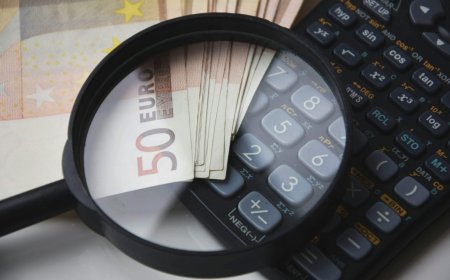Dow Soars 846 Points to Record High as Powell Hints at Rate Cuts
Dow rallies to an all-time high after Powell signals possible Fed rate cuts, fueling optimism across Wall Street.

Wall Street ended the week with a bang as the Dow Jones Industrial Average surged 846 points on Friday, posting a record close after Federal Reserve Chair Jerome Powell hinted the central bank could shift toward easing monetary policy as early as next month.
For investors who have weathered two years of rate hikes and inflation battles, Powell’s remarks felt like a turning point. The Dow finished at 45,631.74, while the S&P 500 climbed 1.52% to 6,466.91. The Nasdaq Composite jumped 1.88% to 21,496.53, lifted by a wave of buying in mega-cap technology stocks.
The market’s rally wasn’t just about numbers—it was about sentiment. After months of uncertainty, Powell’s acknowledgment that risks are “shifting” struck a chord with traders and households alike.
Powell’s Speech: Subtle Words, Big Impact
Speaking at the Federal Reserve’s annual Jackson Hole symposium in Wyoming, Powell avoided grand declarations but delivered just enough to spark optimism.
He noted that the “baseline outlook and the shifting balance of risks may warrant adjusting our policy stance,” citing changing dynamics in tax, trade, and immigration policy. More importantly, he signaled that the balance between inflation control and employment stability is tilting toward easing.
That single line sent ripples through markets. Futures traders immediately boosted bets on a September rate cut, with expectations climbing to 83%—up from 75% earlier in the week.
Chris Zaccarelli, chief investment officer at Northlight Asset Management, summed it up bluntly:
“The bar is extremely high now for the Fed to leave rates unchanged in less than a month.”
Tech Titans Lead the Charge
As often happens in recent rallies, tech stocks were the first to respond.
- Nvidia rose 1.7%
- Meta Platforms gained more than 2%
- Alphabet and Amazon each jumped over 3%
- Tesla soared nearly 6%
The surge in mega-cap names underscored how sensitive growth stocks remain to interest rate policy. Lower borrowing costs could sustain the momentum of tech innovation, particularly in artificial intelligence, cloud computing, and electric vehicles.
But the rally was broad-based too, with cyclical sectors such as industrials and consumer discretionary enjoying solid gains.
Why Investors Care About Rate Cuts
The possibility of a rate cut carries both symbolic and practical weight.
- Cheaper Borrowing: Lower interest rates reduce financing costs for businesses and households.
- Market Liquidity: Investors typically shift into equities when bond yields decline.
- Corporate Profits: Companies that rely on credit—such as automakers and real estate firms—see their margins improve.
- Confidence: Perhaps most importantly, a Fed pivot signals that policymakers believe inflation is finally under control.
For everyday Americans, this could mean lower mortgage rates, reduced credit card interest, and a more forgiving environment for homebuyers and small businesses.
A Market Fueled by Psychology
Beyond the data, this rally tapped into something deeper: relief.
Investors have endured a turbulent two years marked by supply chain shocks, stubborn inflation, and geopolitical conflict. For retirees watching their 401(k) balances shrink, or small business owners struggling with loan payments, Powell’s words offered a glimmer of hope that the tightening cycle is ending.
The human side of markets often gets lost in spreadsheets and trading screens. But Friday’s surge revealed just how much sentiment drives capital flows. Once the idea of a September cut took hold, buyers piled in—afraid to miss out on what could be the start of a sustained bull run.
Risks Still Linger
While Friday’s celebration was dramatic, it would be premature to assume smooth sailing ahead.
- Inflation isn’t conquered yet. Though price pressures have eased, they remain above the Fed’s 2% target.
- Global uncertainties persist, from China’s sluggish recovery to continued instability in Europe and the Middle East.
- Election-year volatility in the U.S. could rattle investor confidence further.
History reminds us that markets often overreact to Fed signals, especially when emotions run high. A cautious Powell may still prefer to see a few more months of cooling inflation before making a decisive pivot.
Wall Street’s Split Personality
Interestingly, not all investors interpreted Powell’s speech the same way. Some analysts viewed his remarks as deliberately ambiguous, designed to calm markets without committing to a firm policy change.
Others suggested the Fed is trying to engineer a soft landing, where inflation cools without triggering mass layoffs or a sharp recession. The challenge lies in timing: move too late, and the economy could stumble; move too early, and inflation might reignite.
Still, the broad rally shows that—for now—Wall Street is leaning toward optimism.
The Story of One Investor
For 62-year-old New Jersey retiree Linda Hernandez, the rally wasn’t just a financial event—it was emotional.
“I watched my portfolio lose nearly 20% in 2022,” she said. “Seeing the Dow hit a record high again feels like a weight lifted. It’s not just about the money. It’s about feeling secure in my retirement.”
Stories like Linda’s illustrate how market milestones ripple through real lives. A new record close isn’t just a headline—it’s a signal of resilience and renewed confidence for millions of Americans navigating uncertain times.
What Comes Next
Markets will now hang on every new data point ahead of the September Fed meeting. Inflation reports, employment numbers, and consumer spending data will shape whether Powell follows through on Friday’s hints.
Key questions for the coming weeks include:
- Will inflation data confirm that prices are steadily easing?
- Can the labor market remain strong while rates decline?
- Will consumer confidence continue to rise on the back of cheaper credit?
The answers will determine whether this rally becomes a sustainable trend or just another spike in a volatile cycle.
Conclusion: A Turning Point or Just a Spark?
Friday’s surge was a reminder that markets thrive on hope as much as hard numbers. Powell’s carefully chosen words ignited a rally that pushed the Dow to uncharted territory and rekindled optimism across Wall Street.
Yet hope can be fragile. Investors must balance enthusiasm with caution, knowing the path ahead is still uncertain.
Still, the takeaway is clear: the era of relentless rate hikes may finally be nearing its end—and for millions of Americans, that possibility is enough to celebrate.
FAQs
1. Why did the Dow surge more than 800 points on Friday?
Because Fed Chair Jerome Powell signaled that the central bank may cut interest rates as early as September, sparking investor optimism.
2. How do rate cuts affect the stock market?
Rate cuts lower borrowing costs, boost corporate profits, and encourage investors to shift money from bonds into stocks, often fueling rallies.
3. Which stocks gained the most from Powell’s speech?
Tech giants led the rally, including Amazon, Alphabet, Meta, Nvidia, and Tesla.
4. Is inflation officially under control?
Not yet. Inflation has cooled but remains above the Fed’s 2% target, meaning further vigilance is needed.
5. Should everyday investors be cautious?
Yes. While the rally is encouraging, risks such as inflation, global instability, and election-year uncertainty still loom.
What's Your Reaction?
 Like
1
Like
1
 Dislike
0
Dislike
0
 Love
0
Love
0
 Funny
0
Funny
0
 Angry
0
Angry
0
 Sad
0
Sad
0
 Wow
0
Wow
0




































































